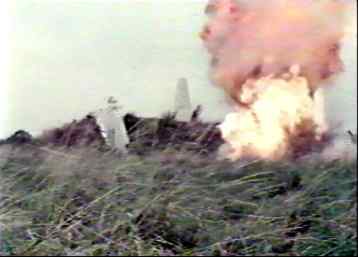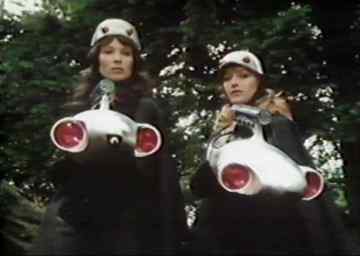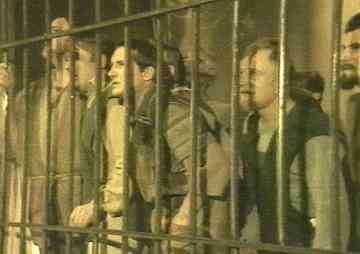
Arle & Berg being blown up.
Governing body of unspecified size, at the top of the Federation's hierarchy. Among the Presidential titles listed by Tarrant in Rumours of Death, one was "Ruler of the High Council". No details were given as to the composition of the High Council, or how its members were chosen. Other references include:
| Part of Control's defences, surrounding the bunker entrance for a radius of "fifty yards, maybe more", at least in Vila's estimate. Avon stated that the rays could burn an individual up in seconds, and noted that it was completely self-repairing in eight seconds. An inbuilt sensormesh was weight and disturbance sensitive. The grid also had the apparent ability to fix people to the spot, preventing their escape. Responsible for the deaths of Arle and Berg, it very nearly claimed Avon as well. It was deactivated to allow Travis and two mutoids to enter the bunker, and Servalan, Jenna and Veron later crossed it unharmed. If it remained deactivated after Blake's escape, then Veron may have been able to get away unharmed, otherwise she would have been trapped in the bunker or killed. |  Arle & Berg being blown up. |
Cited by Vila as a good reason for going back to Earth: "The Himalayas are quite tall at this time of year". The only major geographical feature on Earth to be mentioned by name.
| One of the two factions on Chenga, disagreeing from the Primitives in believing in the use of high technology to better their lives. The Hitechs used Primitives and others as a source of organs for prolonging their own lives, and employed bounty hunters to catch Primitives for such purposes. Vila was brought in by Zee and Barr, whilst Cally was one of 64 people (including Servalan) brought in on a ship picking up survivors from the Intergalactic War. Servalan used her position to escape the Hitechs, but Cally and Vila had to be rescued at the last minute. |  Zee and Barr |
 | A rebel on Earth, working with Sula to depose Servalan and establish a People's Council. Sula persuaded him not to have Servalan killed, and he backed her up in persuading the other rebels in this matter. He was killed by Servalan when he followed Sula to the cellar, distracting Servalan long enough to allow Avon to teleport safely back to the Liberator. |
Egrorian mentioned Hofel as the scientist who over a hundred years previously had predicted many of the properties of neutron star material. Since these properties have to some extent already been predicted, it would seem likely that Hofel's predictions were pertinent to currently unconsidered applications.
Hofel's radiation was released from neutrons subjected to an intense magnetic field. Severe temporal displacement resulted from this - Pinder had aged fifty years in as many seconds after being exposed to Hofel's radiation for a mere millionth of a second. Pinder later released a fatal dose of Hofel's radiation to kill himself and Egrorian.
Since there are references elsewhere in the series to "neutron" drives, it could well be that the process which generated Hofel's radiation was a fundamental principle of time distort drive technology. Protective shielding could be applied against the radiation and its effects, somewhat necessary if the process was used to power crewed spacecraft.
| The place where prisoners were held as the prison ship took off. Described by Vila as "cold as a corpse's armpit". The doorway to the surface was opened by Artix by remote control once the London had taken off. |  |
A command of the Federation's Justice Department, used to halt the execution of sentence on a sentenced prisoner. It could be used if a reasonable doubt was raised about the conduct of that prisoner's case, sufficient to amount to a possible miscarriage of justice. After it was made under those circumstances, an inquiry would usually be ordered to ascertain the truth.
In The Way Back, Varon implicitly stated that this order could be obtained fairly quickly when he told Blake that the latter would be taken from the transit cell back to the city detention area within a couple of hours.
From Ven Glynd's agreement to order an inquiry into Blake's case, it is possible that the Arbiter General's consent was necessary for the issuing of such an order.
See also ARBITER GENERAL, JUSTICE DEPARTMENT.
 The Collar of the Order of the Holy Spirit |
A French order of knighthood, whose badge was part of the gold sash worn
around the waist of the Caliph of Crandor, the lieutenant of the Thaarn. The
order was instituted on 31 December 1578 by King Henry III of France, a monarch
who had a particular devotion to the Holy Spirit, as his birth and accession
to the Polish (1573) and French (1574) thrones all occurred on the day of
Pentecost (also called Whitsunday). It was on that day, the fiftieth after
Easter, that the Holy Spirit descended on the first Christians (Acts 2).
|
|
The objects of the Order were to defend the Catholic faith and to uphold the
Catholic nobility. It had one class, and was limited to 100 members, all of
whom had to be noble and to profess the Catholic faith. The Badge of the
Order is a gold, ball-tipped Maltese Cross, enamelled in white and green,
with a gold fleur-de-lys between each arm. In the centre is a white
enamelled dove flying with the head downwards - the traditional repesentation
of the Holy Spirit. The centre of the reverse is occupied by St. Michael
slaying a dragon. The badge was suspended from a sky blue riband worn over
the right shoulder. A silver star, embroidered with the same cross and dove,
complemented the Badge.
|  The Collar design. |
 The Badge in detail |
The Order was abolished during the French Revolution, but King Louis XVIII
awarded it while in exile, and re-established it in 1814, after the
restoration of the Bourbons. It was again abolished in 1830 by the July
Monarchy of King Louis-Philippe; but awards of it have since been made by
pretenders to the French throne. The reason for the latter actions is that,
at present, the Order is regarded as a dynastic order, one that belongs to a
sovereign Royal House, regardless of the fact that it is not regnant. The Head
of the French Royal House and his legitimate successors continue to enjoy the
right to bestow it, as it is regarded as an order to reward personal services
to the Royal House or its Head.
|
A term used for holy writings, in particular the Bible or Holy Scriptures. In Rumours of Death, when Section Leader Forres asked Major Grenlee if he should seal the perimeter, due to a surveilance malfunction, the latter refused. When Forres pointed out that this was standard procedure, Grenlee responded, 'I don't give a damn if it's Holy Writ'.
This reference, while an implicit one to Christianity, was presumably unwittingly used by Grenlee as a general one to an authoritative text; because the reference had become detached from its Christian origin, both by time and by the Federation's anti-religious policy.
See also CHRISTIANITY.